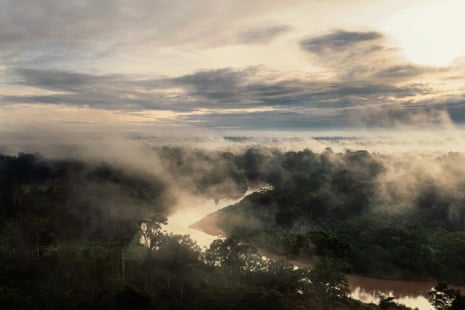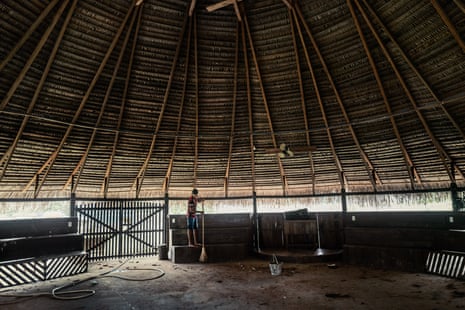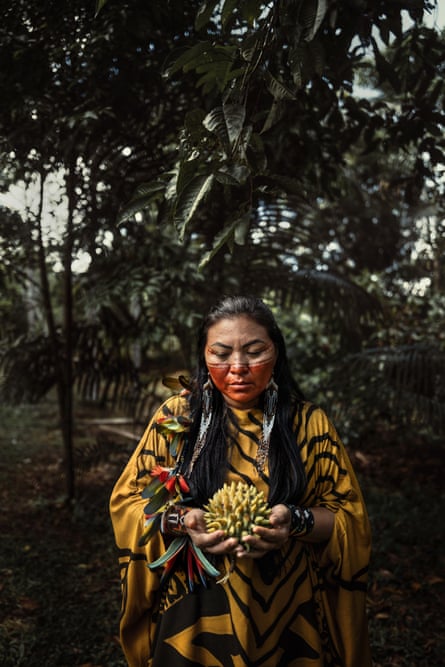[ad_1]
I met Dom through my Indigenous friend, the environmental activist Davilson Brasileiro, with whom I investigated the 2015 Rio Doce disaster. Thanks to Davilson, Dom discovered my work, and we began collaborating on the stories he wrote for the Guardian. It was the beginning of a beautiful friendship, which we often celebrated by surfing together and cooking Italian recipes.
We met for the last time in Rio de Janeiro just before the [coronavirus pandemic] lockdown, to surf at Arpoador beach in Ipanema. We then worked together again, albeit from a distance, for some pieces on Covid-19 in Rio.
In the two years that followed, Dom concentrated on the book he was writing, and on research trips to the Amazon. We talked often, though far apart, about our common passion for music, about life, and made plans for when Covid would pass. We thought about how I could contribute to Dom’s book with my photos, and he asked me to accompany him on [what would be] his last trip, to Brazil’s Javari valley.
There was a long gestation for that trip, a series of green lights to be obtained from the Indigenous communities we would visit. But when the conditions were finally in place to leave, Dom firmly asked me not to come, concerned about the risks I would face. Something he did not tell me about changed his mind, and he left without me. We would do other things together when he returned, he reassured me, once the book was delivered. But not that trip. I found it strange; I was very sorry, but I accepted it.
So, as Dom prepared to leave for the Javari valley, I began new research with Davilson, who first told me about the Asháninka people of the Apiwtxa village and their charismatic leader. This united Indigenous community on the Amônia River in Acre state has become a model for others in their achievements in over 30 years of struggle to defend their territory and culture. We began to think about how to prepare an expedition to that distant territory on the Peru-Brazil border.
A few days before Dom left, we spoke for the last time by phone and I asked him if he knew the Asháninka. Only then did he tell me that he had visited Apiwtxa a few weeks earlier and was very impressed by the villagers’ work in the forest and their way of life. He said they had put into practice the solutions to the problems of the forest. The enthusiasm with which he told me about them aroused even more curiosity in me and motivated me to embark on this adventure with Davilson.

In 1993, the visionary Indigenous leader Benki Piyãko founded the Apiwtxa association, named after the village he and his small community had built. Piyãko, a member of the Asháninka people, one of South America’s largest tribes, had designed a plan for sustainable development that has become widely influential in the decades since.
The way of life in the village is based on reforestation and agroforestry. It is sustainable and largely self-sufficient, maintained and protected by cultural empowerment, Indigenous spirituality and resistance to encroachment from the outside world.

The villagers and Piyãko have planted more than 2m trees and fight to preserve their land and culture. Piyãko has involved international organisations, Hollywood stars and ordinary citizens to support this mission. His work, with that of his community, has made it possible to transform once-devastated land into a lush forest and to help the village of Apiwtxa achieve food security and autonomy while maintaining a balance between the Asháninka lifestyle and culture, and modernity.
The image below captures the first light of day in the Amazon, and the mist that rises from the river and the forest, enveloping everything and then thinning out as the sun gets higher in the sky. It also captures the Amazon’s “flying rivers” – a kind of invisible watercourse that circulates through the atmosphere.
Moisture generated in the Amazon rainforest meets the barrier of the Andes mountains at a height of more than 4,000 metres (13,000ft) and disperses with the winds across South America. The flying rivers contribute directly to the formation of the headwaters of the watercourses that form the great Amazon basin; it is estimated that their flow is equal to or greater than that of the Amazon itself, which is the largest river in the world.

Flying rivers are vital not only to Brazil’s agri-food economy but to the wellbeing of society. This natural phenomenon maintains the balance of climate and biodiversity, protecting ecosystems that are fundamental to the survival of the entire continent.
The Asháninka are a living example of how to respect the forest. Apiwtxa, meaning “unity”, is both the name of the village and a word sacred to the Asháninka, denoting the importance of collective over individual interests – one of the basic principles of community governance.
The Asháninka built this village on the banks of the Amônia River on two former pastures of about 40 hectares (100 acres). It is an isolated location and they have to travel several hours by boat to reach the nearest city. However, they maintain close links with Asháninka communities in Peru, where most of these Indigenous people (numbering about 60,000) live.

-
The Yorenka Tasorentsi health centre, opened by Benki Piyãko, is built according to the principles of traditional Asháninka architecture, which places great importance on the geometry of the roof
Indigenous architecture (above) is inspired by nature and ancestral bioclimatic construction techniques, which naturally maintain a comfortable temperature without affecting the environment.

-
Yoana, 60. The inhabitants of the village are accustomed to silence, to waiting, to observation
The inhabitants of Apiwtxa speak little; they observe with a gaze that seems to peer into the folds of the soul. They almost never ask questions but live in a time marked by the cycle of the seasons, by day and night, light and darkness. They are accustomed to silence, to waiting, to observation; they listen to dreams and the spirit world; they know how to immerse themselves in the unconscious to come out with the answers they seek.

The Asháninka have developed a land-use plan based on agroforestry, reforestation and the collection of non-timber forest products – such as açaí fruit and murumuru oil, a native palm – in a sustainable manner.
Apiwtxa has a seedling nursery and, thanks to all the trees planted around the village, produces an abundance of fruits, both native – buriti, bananas, cashews, cacao and cupuaçu – and non-native, such as coconut and lemon. The agroforestry programme has been an unqualified success, providing food and income, and encouraging the population to take on a kind of ambassadorial role, carrying the message of forest conservation and sustainability beyond their own territory.

The daily routine of the Asháninka begins with a bath, then face painting. One of the natural pigments they use is urucum, in colours ranging from blood red to shades of orange, depending on the ripeness of the fruit. The urucum paste is made from a base of pussanga, an aphrodisiac also known as love oil.
Face painting can indicate the individual’s relationship to their social environment at a given time, while also acting as a means of mystical communication with the spirits of the surrounding nature and the beings the Asháninka worship.

The type of dress worn by Eliane Yawanawá (above) is called a cushma. Clothing is a central element in defining their identity; its production takes months and each piece can last up to a year. Nowadays, Asháninka women wear clothes made from commercial fabrics, but these are naturally dyed and adorned with paintings and ornaments carrying different cultural meanings.

Açaí is the fruit of a palm tree that grows only in wet or flooded soil. It forms in clusters, is spherical and mainly cultivated in the Amazon region. It has become popular internationally, considered a superfood source of good fats, antioxidants, proteins, vitamins and minerals.

-
At the end of the harvest, a child carries a basket full of pupunha, another palm fruit grown by the Asháninka
Pupunha, also known as peach palm, is the fruit of another type of palm, whose trunk is covered in long, sharp thorns. A source of fibre and protein, pupunha is also rich in vitamins and minerals. It is best eaten boiled with salt.

The Asháninka have restored the forest’s biodiversity by managing an abundance of plant species, for use as food and medicine, and this has in turn attracted insects, birds, reptiles and animals to their lands. In this way, they have resumed traditional biocultural hunting activities. Tapirs, agoutis, monkeys, armadillos, turtles and caimans are real delicacies, as well as a source of protein in their diet.

-
Benki Piyãko, spiritual and political leader of the Asháninka, invokes the strength of mystical beings in the forest he and his community planted
By planting millions of trees in the Amazon, Piyãko and his community have demonstrated to the local population that they can live a healthier, more prosperous and sustainable life if the forest is preserved.
The Asháninka reject the idea that humanity is separate from nature and that nature is subject to people. For them, human beings, plants, trees, animals, birds, mountains, waterfalls, rivers and the spiritual beings of the forest can speak, feel, think and relate to each other. “If the ecological balance breaks down,” Piyãko says, “the world feels it, gives warnings, alerts … Thinking, reflecting is very important, but one cannot wait too long to do things … Our head is like the world and the world is like our head.” [where is this quote from?]
In 2018, Piyãko opened the Yorenka Tasorentsi health and education centre, where he treats illnesses with traditional plant therapies, reconnecting people to the natural environment and its life cycles. For his work in Apiwtxa, Piyãko has received the UN Equator prize and the Culture for Peace award.

-
Flechas Kawatum, leader of a delegation to Apiwtxa from the Kayapo people, who live in the Brazilian state of Mato Grosso
In March 2023, Flechas Kawatum, 54, a Kayapo warrior (above), brought a delegation from the Kayapo people of Mato Grosso to Apiwtxa to learn first-hand about the forest management and reforestation work and the daily life of the Asháninka.

Music and song play a central role in the cultural traditions and spirituality of the Asháninka, a channel for the energy of the earth and a portal to the spirits of the ancestors. The image above presents a striking contrast between the young man on the left with his traditional tapo drum and face paint, wearing a cushma hand-woven from cotton grown in the village, and the western clothes and technology of his companion, using his mobile phone.
[ad_2]